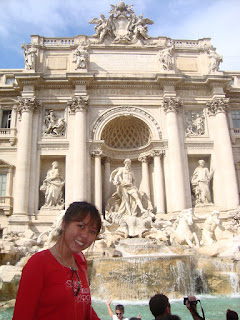19 Sept 2009
Pisa
Pisa is a city in central Italy. It is the capital city of the Province of Pisa. We had a chance of exploring the "Miracle Square" where it boosts of the three of the world wonders. Most of the people have heard about the Leaning Tower, but do not realize that there are also two significant buildings lying next to it, which is UNESCO World Heritage Site and the Baptistry of the Cathedral. Well, we were aware the existence of the other two buildings after guided by our tour guide, but still we were concern with the leaning tower. Many of us posted differently with the tower, while i chose to kick the tower.
pic: The leaning tower


pic: Baptistry of the Cathedral
 pic: UNESCO World Heritage
pic: UNESCO World Heritage
Florence
The capital city of the Italian region of Tuscany and of the province of Florence. It is the most popular city in Tuscany, with 367.569 inhabitants.
St Mary of the Flowers Church
We headed to Florence. St Mary of the Flowers church stood out so much that we could still see it from our coach no matter which direction we turned. It is huge, very huge and we were not able to fit its entire body into our camera lense.


The door of paradise
It is too technical to understand and explain this. If you do really hope to know more, please read the following link:

Signoria Square
Built around the end of the thirteenth century as a symmetrical contrast to the city's religious centres, Piazza della Signoria was enlarged through demolitions of the tower-houses of the Uberti, Foraboschi and other powerful Ghilbelline families.
It has always been the civic centre of Florentine life. Although same original buildings and the ancient brick paving, which gave it greater unity of style, have now disappered, it remains in all its aspects a square of incomparable beauty and elegance.
Ponte Vecchio
It is a Medieval bridge over the Arno River, noted for still having shops built along it, as was once common. Butchers initially occupied the shops; the present tenants are jewelers, art dealers, and souvenir sellers. It has been described as Europe's oldest wholly-stone, closed-spandrel segmental arch bridge, but there are fal older bridges.

The statue of David
The statue came to symbolize the defense of civil liberties embodied in the Florentine Republic, an independent city state threatened on all sides by more powerful rival states and by the hegemony of the Medici family. The eyes of David with a warning glare, were turned towards Rome.
pic: status of david




















 pic: Mosaic of the transfer of St. Mark's body. Photo ©
pic: Mosaic of the transfer of St. Mark's body. Photo © 































